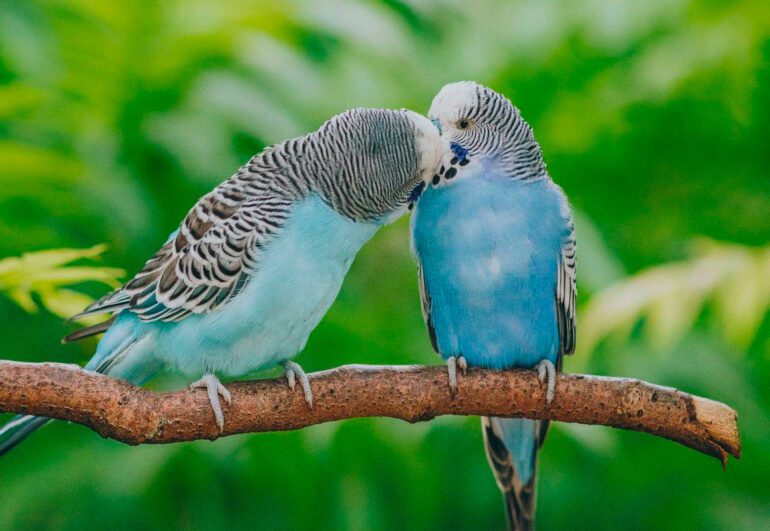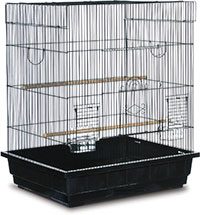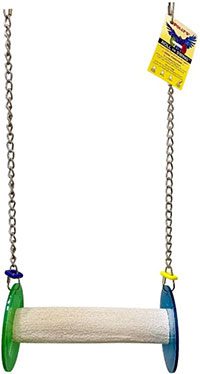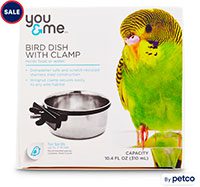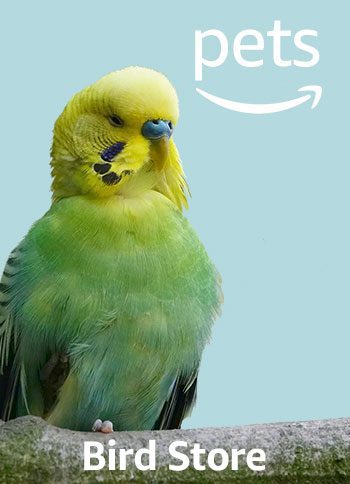Parakeets, also known as budgerigars, are related to parrots and can make great family pets. Their beautiful colors, unique personalities and high intelligence make them a well-loved animal and pet. Parakeets have specific care needs.
Their care and living needs are quite simple with some research and preparation. Parakeets can live for up to 20 years when kept in good health and treated well. With such a long lifespan, it’s important to remember a pet is a lifetime commitment and should be taken very seriously.
That’s why we put together this guide to owning a parakeet and parakeet care. By the time you’re done reading, you’ll know exactly how to take care of parakeets and what they need to live a long, happy life.
Are Parakeets Easy To Take Care Of?
Yes, parakeets are relatively easy to take care of, especially compared to other exotic birds. When keeping a budgerigar or parakeet as a pet, they’re also likely to be very social, sweet and loving towards you.
The thing is, owning a low maintenance pet doesn’t mean no maintenance. You still need to spend time caring for your bird every day. For example, you have to feed your pet parakeet no less than every 24 hours or risk illness because of their fast metabolism. Forgetting to change their bedding regularly can lead to illness, too.
Basically, parakeet care is much easier to manage than cockatoo or macaw care. But you’re still responsible for managing the health and environment of your pet parakeet.
What Do Parakeets Need?
For optimal health and happiness, parakeets need:
- A roomy cage with bedding, perches and stimulating toys
- Food to suit their dietary needs and daily feedings
- Clean, fresh drinking water
- Attention to their overall health
Cage, Bedding, Perches and Toys
The ideal cage should be 14 inches long, 16 inches high and 17 inches wide, making it longer rather than taller. The parakeet should have enough space in the cage to fully stretch their wings and fly around. Square-topped cages are preferred rather than round or decorative cages, as these birds fly horizontally. Cages shouldn’t be in direct sunlight, direct line of drafts or air conditioning, as these birds are sensitive to temperature changes.
Our top choice is the Prevue Square Roof Bird Cage. The size and shape make it perfect for your pet parakeet. Plus, it’s got plenty of features to make your life easier, like a pull-out bottom tray for cleaning, side carrying handles and doors specifically for refilling food and water dishes.
Perches are another important factor in any cage. A perch should be the correct size for the bird’s feet or they might not be able to grip it. There should also be different types and textures of perches within the cage. Ensure your perches aren’t placed over sources of food or water to prevent droppings from falling into them.
Toys such as bells, ropes and ladders can be added to further increase stimulation. We love Polly’s Pet Bird Roll and Swing because it serves as both a perch and a stimulating swinging toy for your bird.
When it comes to keeping parakeets as pets, bedding is crucial. It helps them feel more secure, protects from drafts and absorbs droppings, keeping your bird healthier. We always opt for So Phresh Odor Control Crumbled Pine Bird Litter because it’s low-dust, free from artificial chemicals and it makes cage clean-up a breeze.
Parakeets don’t necessarily need a bird bath in their cage, but if you decide to add one, it needs to be cleaned out regularly. Alternatively, you can use misting bird bath spray bottles to help your bird stay clean.
The Lixit Quick Lock Bird Bath is a great choice because it can clip securely onto your parakeet’s cage, keeping it from tipping over and making a mess. It’s also easy to remove, which makes cleaning the bath fast and simple.
Food
The diet of a parakeet should include variety to keep their nutrition balanced. Eating seeds exclusively won’t provide your pet with all the necessary vitamins and minerals. So, a mix of pellets, seeds, fruits and vegetables is ideal.
Offer your parakeet fresh pellets or seeds every day, such as Lafeber Parakeet Pellets or Brown’s Encore Premium Parakeet Food. Some parakeets have a habit of only eating the top layer of pellets in their food bowl. If this is the case, refresh the pellets more often throughout the day to ensure they’re eating enough food.
Parakeets can also have dark green and yellow vegetables, such as broccoli, carrots and sweet potatoes. Fresh fruit should be given in reserve, as too much sugar can harm them. Remove uneaten, fresh food after 2–3 hours to prevent the parakeet from eating spoiled food.
A cuttlebone or mineral block can be added to their cage to give them additional supplements and help trim their beaks. The Polly’s Pet Products Cuttlebone and Calcium Bird Perch offers your bird digestible calcium with a yummy pineapple flavor, and it doubles as a perch.
If your pet parakeet’s droppings become runny, they may be receiving too much water intake from fresh food, so decrease the amount offered. Cages should be cleaned once a week to prevent droppings from building up, which encourages bacteria growth.
Water
It’s extremely critical that parakeets receive fresh water daily and that their water dish be kept clean. They are sensitive to water-born bacteria that can cause illness and even death when not treated. Make sure you use only bird-safe cleaning sprays when washing out bowls and cages.
Our favorite food/water tray for a pet parakeet is the You & Me Stainless Steel Coop Cup with Clamp. We love this option because it clamps onto the cage, which helps prevent spills. More importantly, the stainless steel won’t leach harmful chemicals into your pet’s water like some plastic dishes.
Health Care
Keeping parakeets healthy is an important step to ensure they live full and happy lives. In addition to being sensitive to temperature changes and bacteria, be mindful of other potential changes in their health. If your parakeet begins to pluck their own feathers, they may be bored, sick or stressed. Contact your local, small animal veterinarian to get detailed guidance and care.
How To Take Care of Parakeets
Here’s how to handle parakeet care:
- Clean the cage and set up everything inside before bringing the bird home.
- Put the cage in a room you spend much of the day in so they don’t get lonely.
- Once your bird settles in, give them time out of the cage while perched on your finger (be sure to close windows, turn off fans, etc., first!).
- Feed your parakeet pellets daily.
- Supplement their diet with seeds, vegetables and fruit.
- Change the food and water daily, which also helps prevent illness.
- Socialize for a total of at least 90 minutes daily by talking or singing to your bird, engaging with their toys or having them perched on your finger.
- Drape a towel over the cage at night so they can sleep.
All in all, owning a parakeet is a fun and rewarding experience. Take good care of your parakeet and they will love you their whole life.

